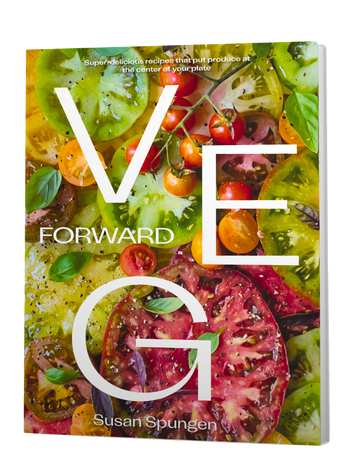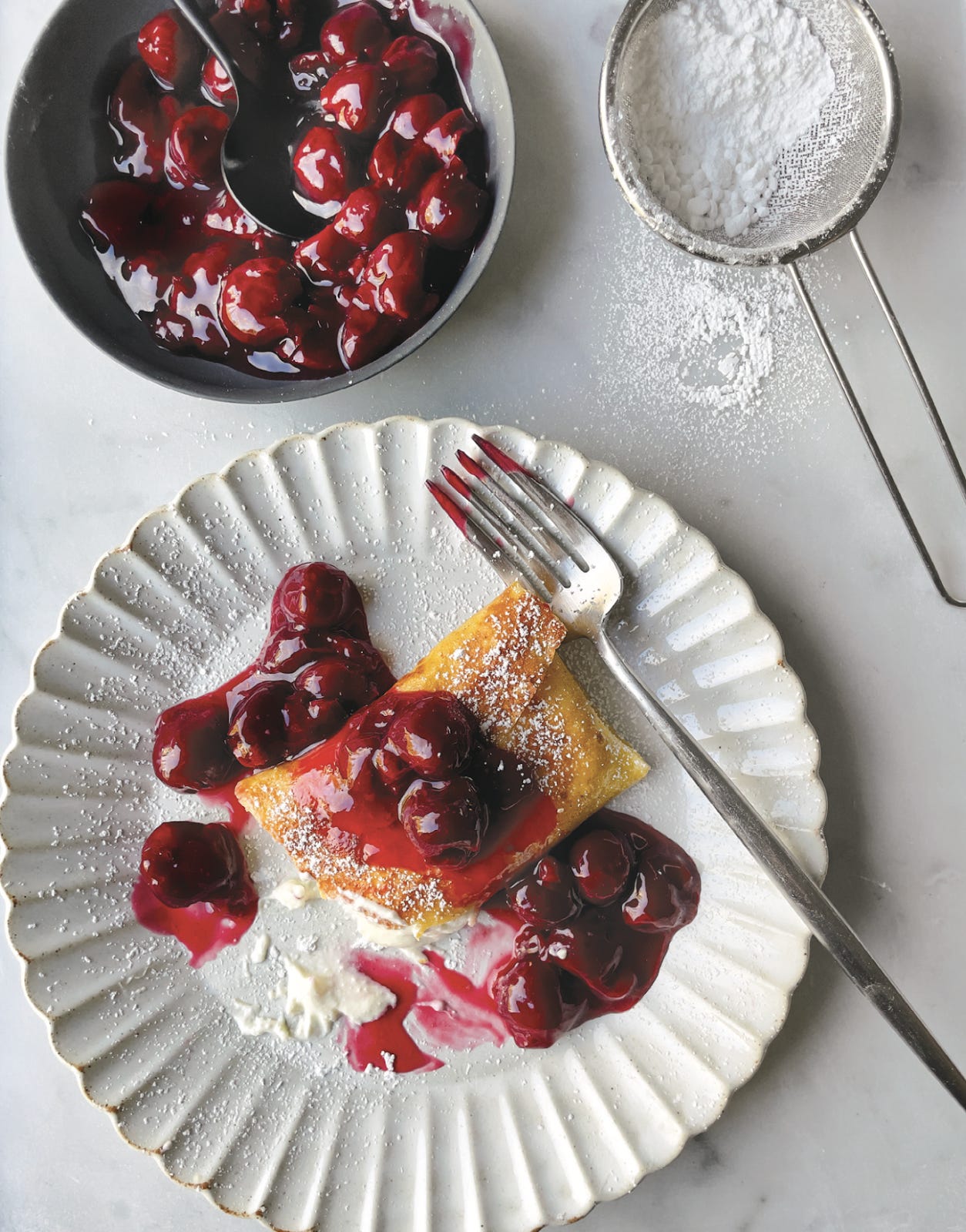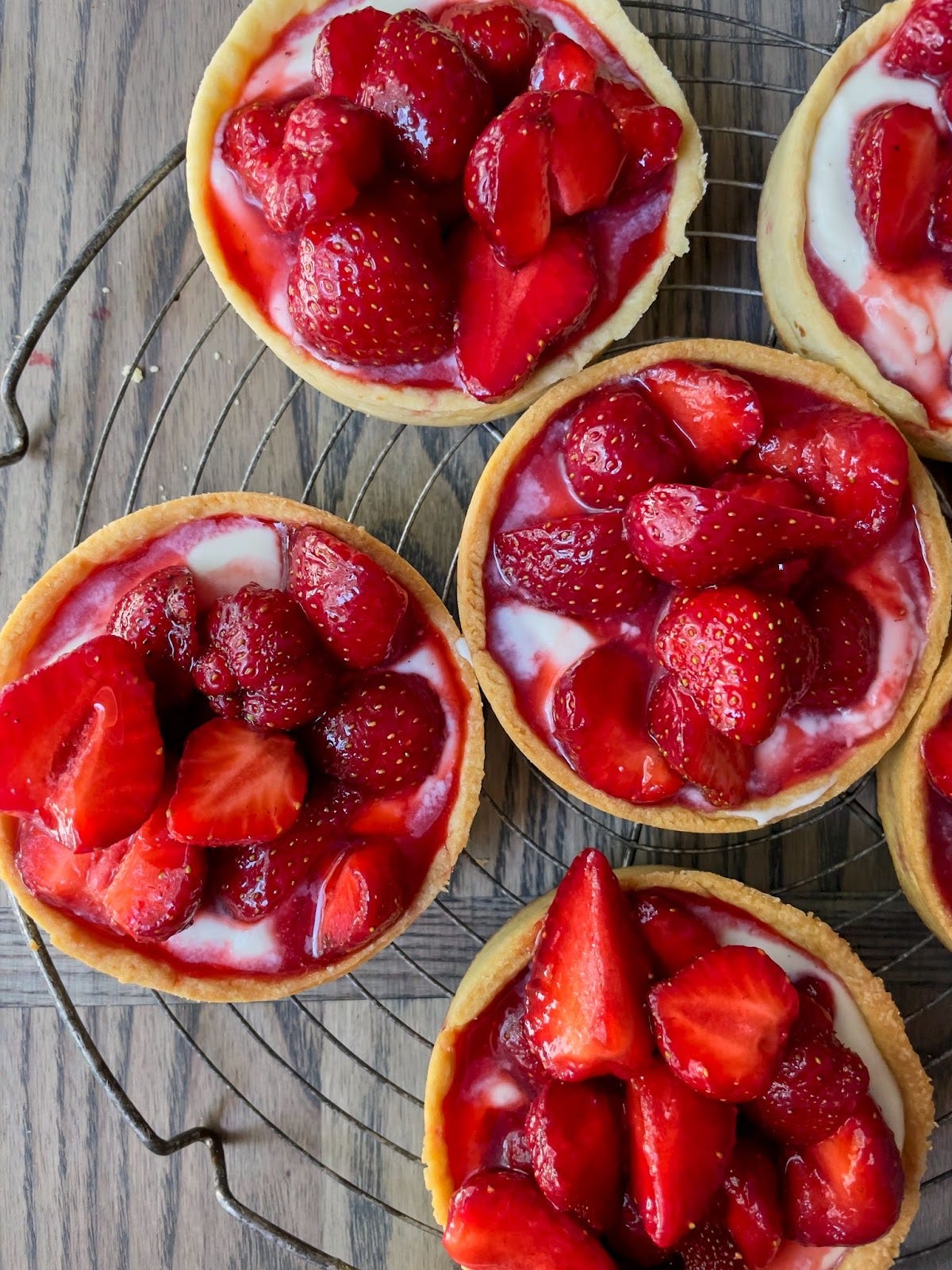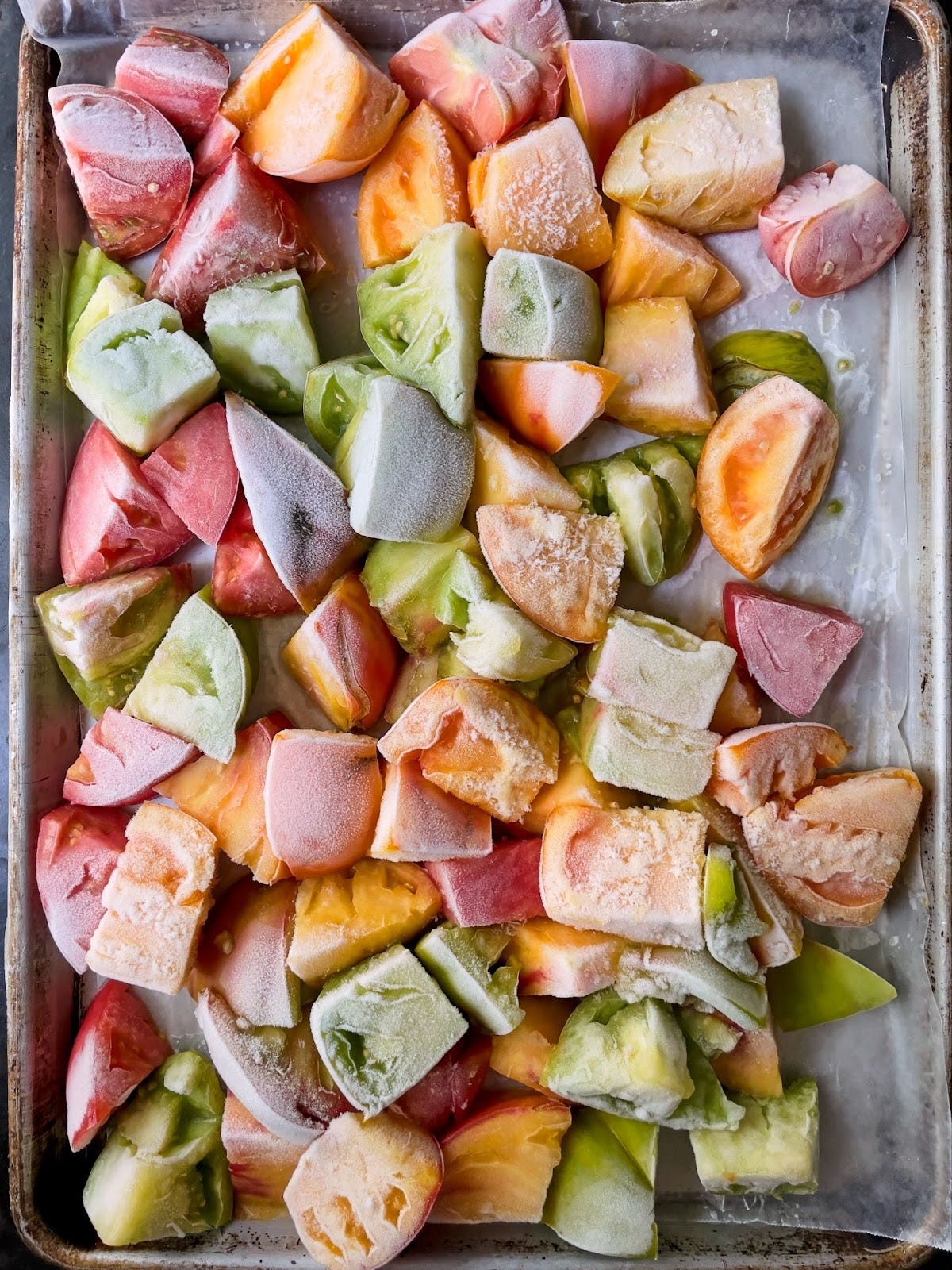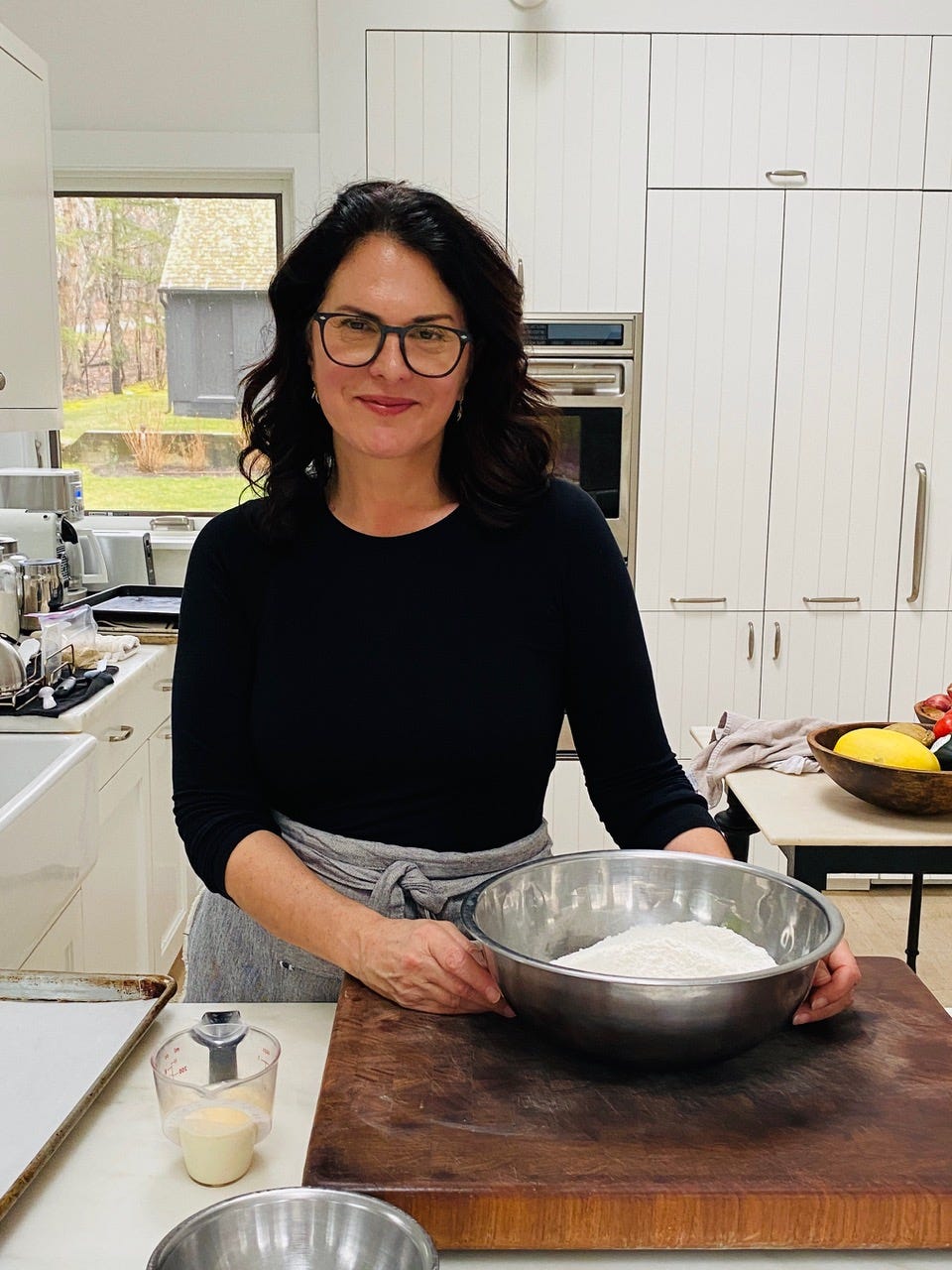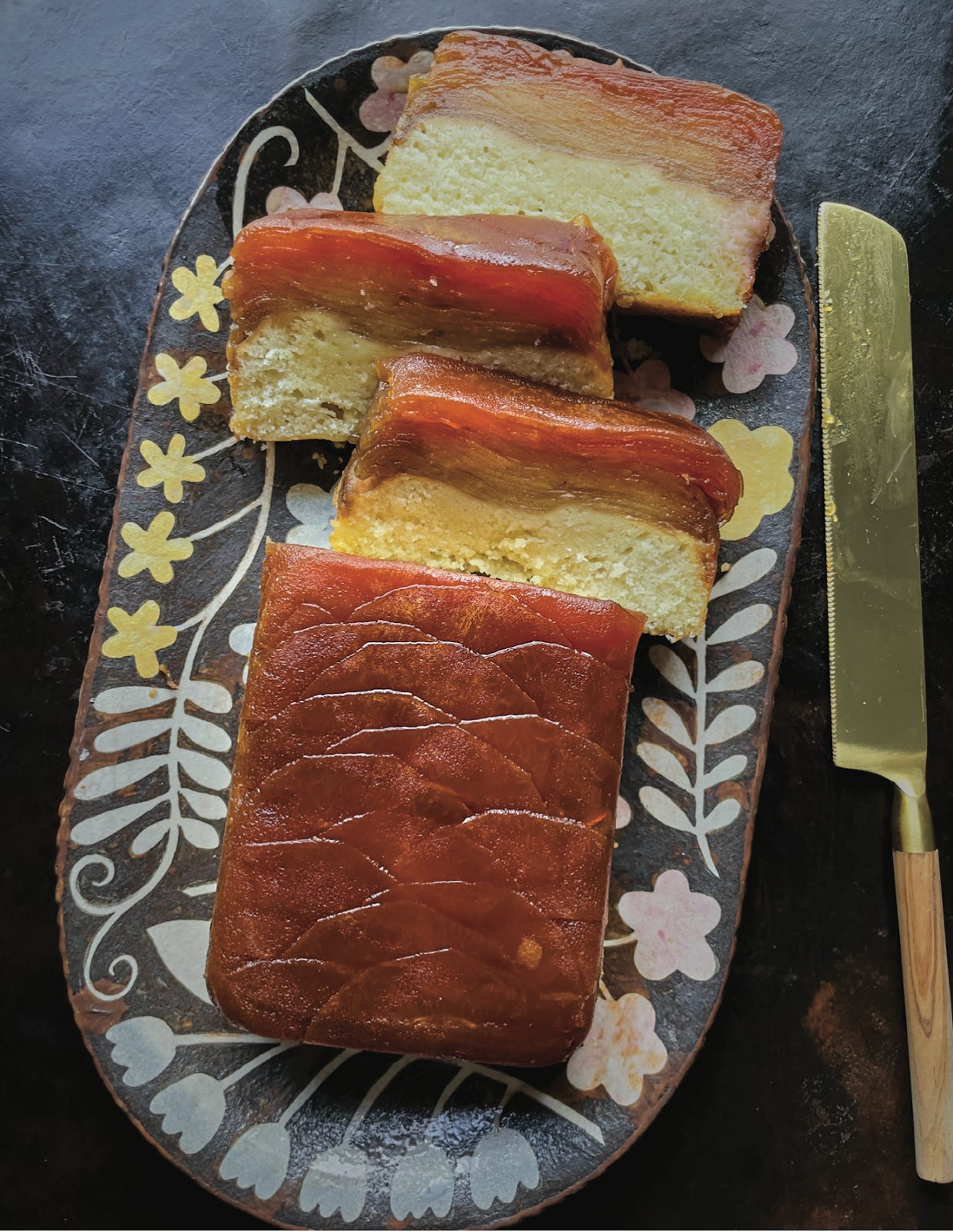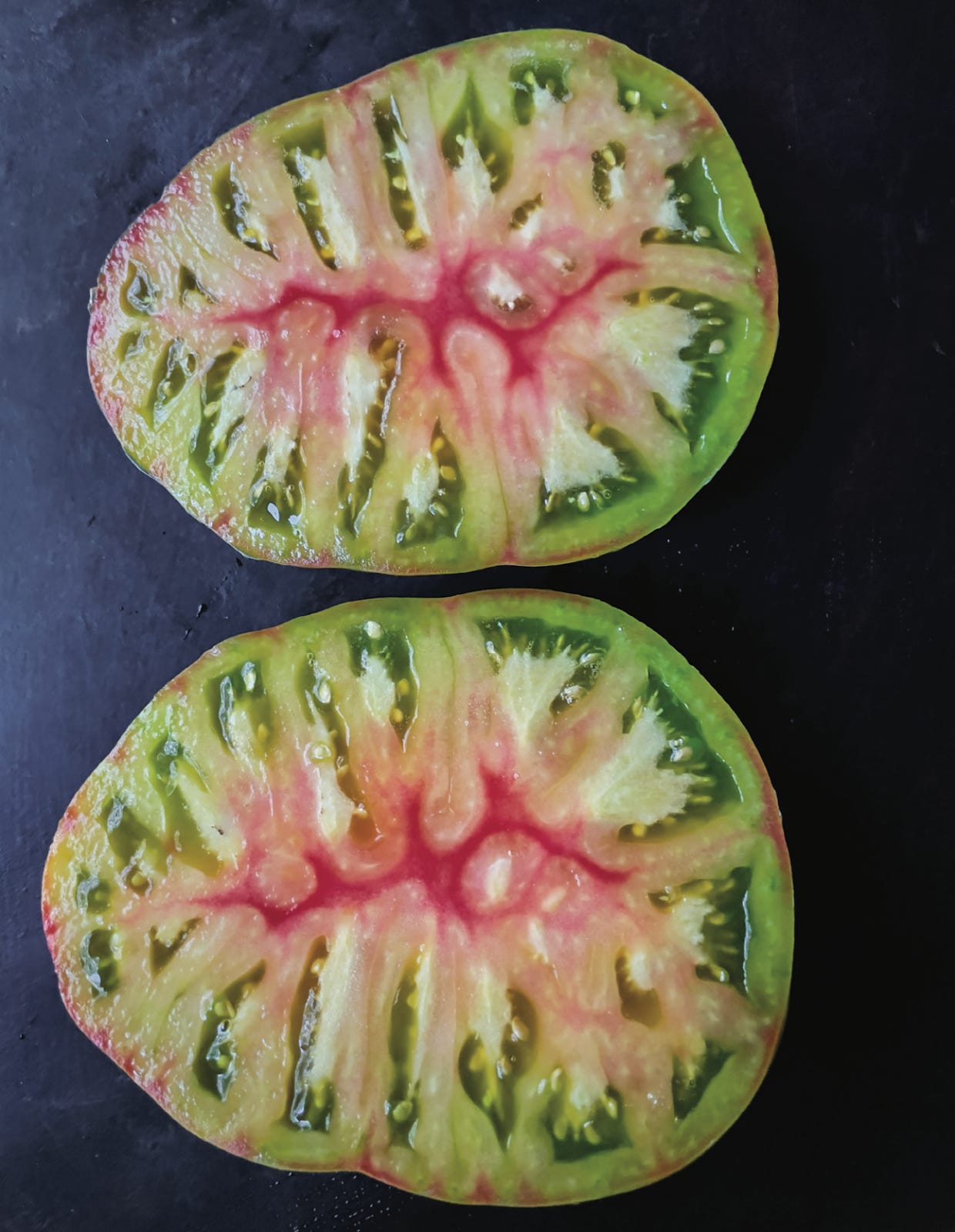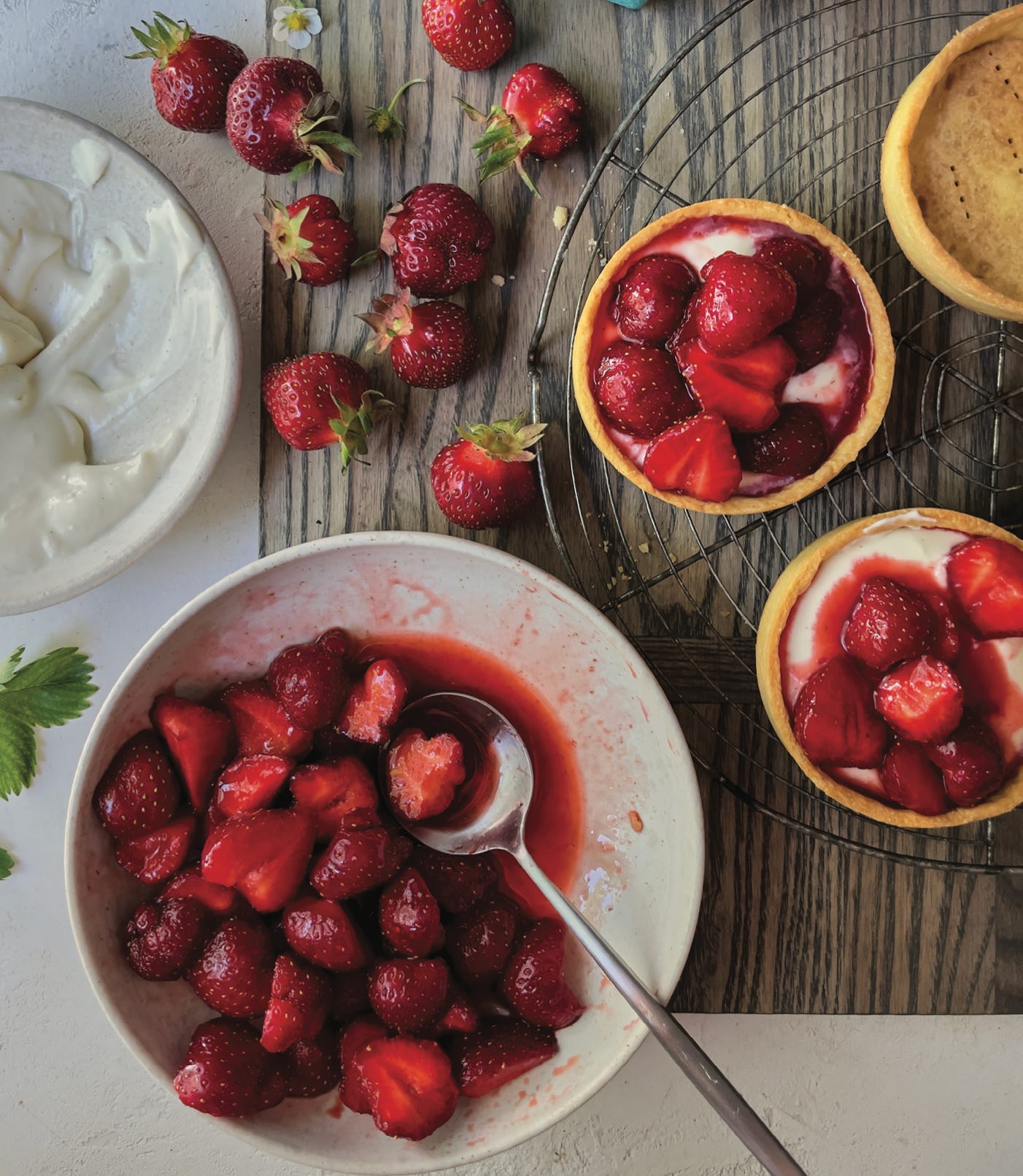Kitchen Project #104: Strawberry & Goats Cheese Tartlets
From 'Veg Forward' by Susan Spungen ft. author Q&A!
Hello,
Welcome to today’s edition of Kitchen Projects. It’s so wonderful to have you here.
Today I have the honour of sharing a recipe from the brilliant Susan Spungen, author, food stylist and fellow substacker. I love to celebrate new cookbooks, and Susan’s ‘Veg Forward’ has so much to offer. We’ll start by diving into how the book was made and finish with a recipe for Strawberry Goats Cheese Tartlets. Outrageous.
Over on KP+, it’s a love letter to the most summery of liquids: TOMATO WATER! I’ll tell you all about it and then we’ll finish with Susan’s genius method + recipe for tomato water lemonade. Summer heaven. Click here to make it.
What’s KP+? Well, it’s the level up version of this newsletter. By joining KP+, you will support the writing and research that goes into the newsletter and get access to an amazing community, extra content, the full archive, and more. Subscribing is easy and only costs £5 per month. Why not give it a go? Come n join the gang!
Love,
Nicola
True Susanality
Susan Spungen is an author, food stylist, recipe developer, chef, photographer and fellow substack-er (You gotta sign up to Susanality!).
She is an accomplished, trusted voice in the food world with three books under her belt as well as a storied career as the founding food editor of Martha Stewart Living. Loved the food in Julie & Julia? What about Eat Pray Love? You’ve got Susan to thank for that.
Last year I had the pleasure of sitting down (digitally) with Susan and getting the lowdown on her life and career, and I got to pick her brains about the wide world of American style scones (if you haven’t made her Strawberry Scones yet, what are you doing?!).
I’m thrilled to welcome her back to the Kitchen Projects with exciting news: Her new book, Veg Forward, is out now.
One of the most colourful books I’ve ever seen, Veg Forward is a celebration of the season's bounty. By placing vegetables at the centre of the plate, the majesty of nature is immediately obvious. Mottled borlottis, alien landscape tomato cut-throughs, a wave of frilly greens, rothko’d dressings. Vegetables are given the main character treatment and let me tell you, they look incredible. Total superstars. Who needs a roast chicken?!
Veg Forward is packed with flavourful recipes that beg to be made: Cheese blintzes with sour cherry compote, squash blossom quesadillas, Tardivo with warm anchovy dressing, sunchoke salad with fried capers, greek slab sandwiches and caramel apple brown butter buckles. What’s a buckle? Well, it’s a cake that has so much fruit that it ‘buckles’ under its own weight. I’m beyond charmed.
And one thing that I still can’t quite get over: Susan photographed the entire book herself. With her iPhone. Is your mind blown?! I officially no longer have any excuses for sub par photography.
I’m so thrilled to be sharing a Q&A with Susan where we delve into the making of Veg Forward, from conception to all the styling and photography at home. And I am honoured to be sharing a stunner of a recipe from the ‘Spring’’ section: Strawberry and Goats Cheese tartlets.
If you’ve made my feta + fig cheesecake, you know I’m a huge fan of the cheeseboard flavour profile turned into a fancy dessert aesthetic. Creamy goats cheese is tempered with creme fraiche and the strawberries are macerated with booze to make an extraordinary end to any meal.
Over on KP+, I’m delighted to share another Veg Forward recipe: Tomato Water Lemonade.
If those three words don’t have you jumping for joy, I think you should definitely head over and see what it’s all about. Tomato water is one of those secret ‘cheffy’ tricks that is actually very simple and you’ll be amazed at the way it tastes. Pure tomato essence in a completely clear liquid. And Susan’s method is genius! You know I LOVE a drink recipe and rest assured, it’s what I’ll be drinking all summer long.
Alright, let’s chat with Susan!
Susan Spungen x Veg Forward Q&A
What is the origin story for Veg Forward - how did it come about?
SS: Ah, the origin story. To be honest, I’ve wanted to write this book for years. I’ve always had some version of it near the top of my “Book Ideas” list. I was told in the past that seasonal books don’t sell well, and was discouraged from pursuing it. I secretly snuck the concept into my other books, because it is what makes me tick. Gorgeous produce is my inspiration, always. It’s the framework for most of the food I cook and the recipes I write. Plus, the time is right for everyone to eat more vegetables and less meat, and I hope this book inspires people to do that with joy.
Where did you begin with developing recipes for a book? Did you have a vegetable hit list?
SS: I definitely had a vegetable hit list! It seemed like a natural place to start, and it helped me figure out what the structure of the book should be. I went back and forth between organizing it by vegetables, or groups of vegetables, or by seasons. Eventually I settled on seasons because that’s how I cook. That said, there are many recipes that can be easily made in a season than the section it appears in. The index makes it easy to look up a vegetable that you have to find recipes that use it.
Were there any recipes that were hard to get right?
SS: Oh, there’s (at least) one in every crowd. For the most part, no, but since I did include desserts (it seemed wrong to leave fruit out of this book), and the line can get fuzzy between what is technically a fruit or technically a vegetable, I decided not to get hung up on that. I digress though. The Apple Confit Cake, which is the last recipe in the book. It may seem time consuming (it is, but worth it!), and it took me umpteen tests to get it to the point where I felt comfortable sharing it. When you consider that it is inspired by a classic apple confit made famous by chefs like Jean Georges Vongericten and Pierre Hermé that takes as many as 24 hours to make, it’s like a walk in the park! I just had to include it.
Tell me a bit more about your photography process - I’m so amazed you took them all and on your phone at that! (My flour/butter covered iphone lens could never…). What were the positives, and what were the limitations?
SS: Great question! I had already gotten pretty good at IPhone photography after years of developing a style for Instagram, so I figured, why not? I asked a friend, Andrea Gentl (who is a photographer I trust and admire) if she thought it was a good idea, and she encouraged me, assuring me that the resolution was high enough to work in print. I showed my editor some images as examples, and she liked them, so I started shooting. In most cases, I would focus on props, lighting, and composition at a separate time from when I was first developing the recipe, but I would always shoot it each time I made the recipe so I would get a 2-D roadmap for where I should go next. Occasionally, I would get the shot on the first try. I would pick out props and a background before I started cooking so I could just focus on the food. And yes, I always kept a microfiber cloth nearby to clean the lens just before shooting. Very important! I always enlarged the image to make sure everything was sharp while the food was still on set, and hired a digital tech I had worked with on my last book to do the file management and color correction.
For people wanting to take better photos at home, do you have any tips?
SS: I would say that light is the most important thing, so you should pay attention to where the light is in your house at different times of day and different times of year. Walk around your home with a plate of food and try out different windows to see which ones make the food look best. Mine turned out to be a single window in an otherwise dark room that had north light, usually coming from the left. I also liked a window that gets western light at the end of the day, when there was harder light coming from the right side of the images. It’s easy to see which is which if you look through the book. It’s also helpful to have a few basic things to manipulate the light. A scrim to soften hard light, a white card to lighten shadows, and a black card to deepen them.
My first good apricot of the year is something I always look forward to. What is your ‘best’ first of the season?
SS: I would have to say asparagus, because they signal the beginning of the growing season, and are such a delight.
If you could gift any US-only veg variety to the rest of the world, what would it be?
SS: I’m not sure I can answer this question, because I’m not sure what we have in the U.S. that isn't available elsewhere. I’ve never lived in another country. You must be aware of something since you have! Cranberries and pecans come to mind, but they’re not vegetables!
Conversely, are there any veggies from other continents that you wish were available on your doorstep?
I think we get most everything, whether it’s imported or grown by specialty growers, but again, not sure about this one. What I wish was more popular and easily available here is artichokes. When you go to Italy and see the array or shapes, colors, and sizes, you realize that our selection pales in comparison.
I love the way you celebrate the ephemeral nature of the seasons - the story of you unsuccessfully seeking an heirloom tomato that would rival the one you randomly sliced into one evening is charming and a good reminder to ‘strike whilst the iron is hot’. Do you have any good advice on how to buy good produce?
SS: Well, you said it, Strike while the iron is hot! I try to buy what’s in season. Prices are better, and the produce is fresher. I like to buy directly from the farmer when I can, whether that’s in the NYC Greenmarket, or at my local Long Island farm stands. You’ll notice that when you do this, the produce lasts much longer in your fridge compared with what you buy in a supermarket which is often at the end of its life by the time you get it home. Don’t be put off by slight wilting of greens if you see that at a stall. It’s hard to keep food fresh all day out of refrigeration. Usually a nice cool bath will bring it back to life.
Try as I might to be as seasonal as possible, I’m guilty of buying courgettes in October every now and again, but I wouldn’t dare to eat a peach in December. What is your biggest off season no-no?
SS: We are all guilty of that! As long as the quality is good, there’s no reason to be ashamed! I really avoid larger slicing tomatoes when they’re not in season. Even though we get reasonable facsimiles of heirloom tomatoes that are greenhouse grown, they’re just not the same. They do come in handy for food styling though in a pinch. I do buy courgettes (zucchini!) at any time of year for certain recipes as long as they are bright green and shiny. In the U.S, we have so much great produce that only comes from as far as California all year long, so as long as it looks fresh, I buy it.
What is the one thing you hope people will take away from Veg Forward?
SS: The main thing I hope people learn from this book is to be creative when approaching everyday, humdrum vegetables and discover new and exciting ways to prepare them, so they’ll want to eat more of them! I also hope that it spurs each cook’s creativity and gives them permission to make substitutions if they can’t get exactly what’s in a recipe. The recipes are designed to be riffed on!
Thank you so much, Susan! Veg Forward is out now and available across the US and can be ordered in the UK. Her newsletter ‘Susanality’ can be found here. You can also follow Susan on Insta @SusanSpungen or find more about her at
https://www.susanspungen.com/
Alright, let’s get onto the recipe!
Strawberry Tartlets With Goat Cheese Filling
By Susan Spungen, excerpt from Veg Forward
When strawberries are at their peak, I serve them as simply as possible: over a creamy, tart filling in a delicate, crackly crust—polite but delicious supporting players. This is a kind of do-it-yourself tart kit whose components can be made ahead of time and carted off to your friend’s house or a picnic for last-minute assembly. You can use any individual tartlet molds, but I especially like French flan rings. They are a little trickier to work with, since they have no bottom (they look like bracelets), but I like the modern lines and the large capacity of the shells as opposed to the fluted kind.
Ingredients
For the tart shells
1 1/2 cups/192 g all-purpose flour, plus more for rolling
1/3 cup/34 g confectioners’ sugar
1/4 teaspoon kosher salt
1/4 teaspoon baking powder
8 tablespoons/113 g (1 stick) cold un- salted butter, cut into pieces
2 large egg yolks, lightly beaten
For the filling
4 ounces/113g soft, mild goat cheese
1/4 cup plus 2 tablespoons/47 g confectioners’ sugar
1/2 teaspoon pure vanilla extract or vanilla bean paste
8 ounces/226g crème fraîche
For the strawberries
4 cups/1 pound/450g strawberries, hulled and sliced in half, quartered if large 2 tablespoons granulated sugar
1 tablespoon Aperol (optional)
Instructions
To make the tart shells: Pulse the flour, confectioners’ sugar, salt, and baking powder in a food processor. Add the butter and pulse to combine until it is in small pea-sized pieces. With the food processor running, slowly add the egg yolks through the feed tube. Stop the machine just as the dough begins to come together. Transfer the dough to a flour-dusted surface and knead it once or twice to make sure it is well mixed. Wrap the dough in plastic, flatten it into a disk, and refrigerate until firm, at least 1 hour.
To make the filling: In the bowl of a stand mixer with a paddle attachment (not a food processor), blend the goat cheese, confectioners’ sugar, and vanilla at medium speed until smooth. Add the crème fraîche and gently mix at low speed until just combined. Transfer to a bowl and refrigerate until needed.
To bake the tart shells: Heat the oven to 375°F (170c fan). Line a baking sheet with a silicone baking mat or parchment paper. Divide the dough into 4 pieces; refrigerate 3 of the pieces. On a well-floured surface, roll one piece of dough into a circle that is about 1/8 inch thick and slightly larger than the tart rings you are using. Press the dough into a tart ring, allowing the excess to hang over. Roll over the top of the tart ring with a rolling pin to remove the excess dough. Repeat with the other 3 pieces of dough, then reroll scraps as needed to fill all 6 rings.
Prick the dough all over with a fork, transfer the lined tart rings to the prepared baking sheet using a spatula, and refrigerate for 15 minutes, or until firm.
Line each tart shell with a piece of buttered foil, fill with dry beans or pie weights, and bake for 15 to 17 minutes, or until golden at the edges. Remove the foil and con- tinue to bake, uncovered, until evenly golden, 3 to 4 minutes. Cool completely. (You can make the tart shells up to 2 days ahead.)
To make the strawberries: Mix the strawberries, sugar, and Aperol (if using) together in a large bowl and set aside to macerate for at least 10 minutes, until the sugar is dissolved and the strawberries look juicy, tossing occasionally.
To assemble the tarts: Divide the cream and berries among the tart shells, starting with a layer of cream and finishing with the berries. Serve immediately.
Notes:
You can make this as one big tart: Lightly butter sides and bottom of a 10-inch removeable bottom tart pan. Roll the dough to a 13-inch circle, 1/8-inch thick. Follow instructions on page 45 for blind-baking crust. Blind bake for 15 minutes. Remove weights, then bake 8 minutes until evenly golden. Fill the shell with the cream filling and chill for 1 to 2 hours before filling with berries.




